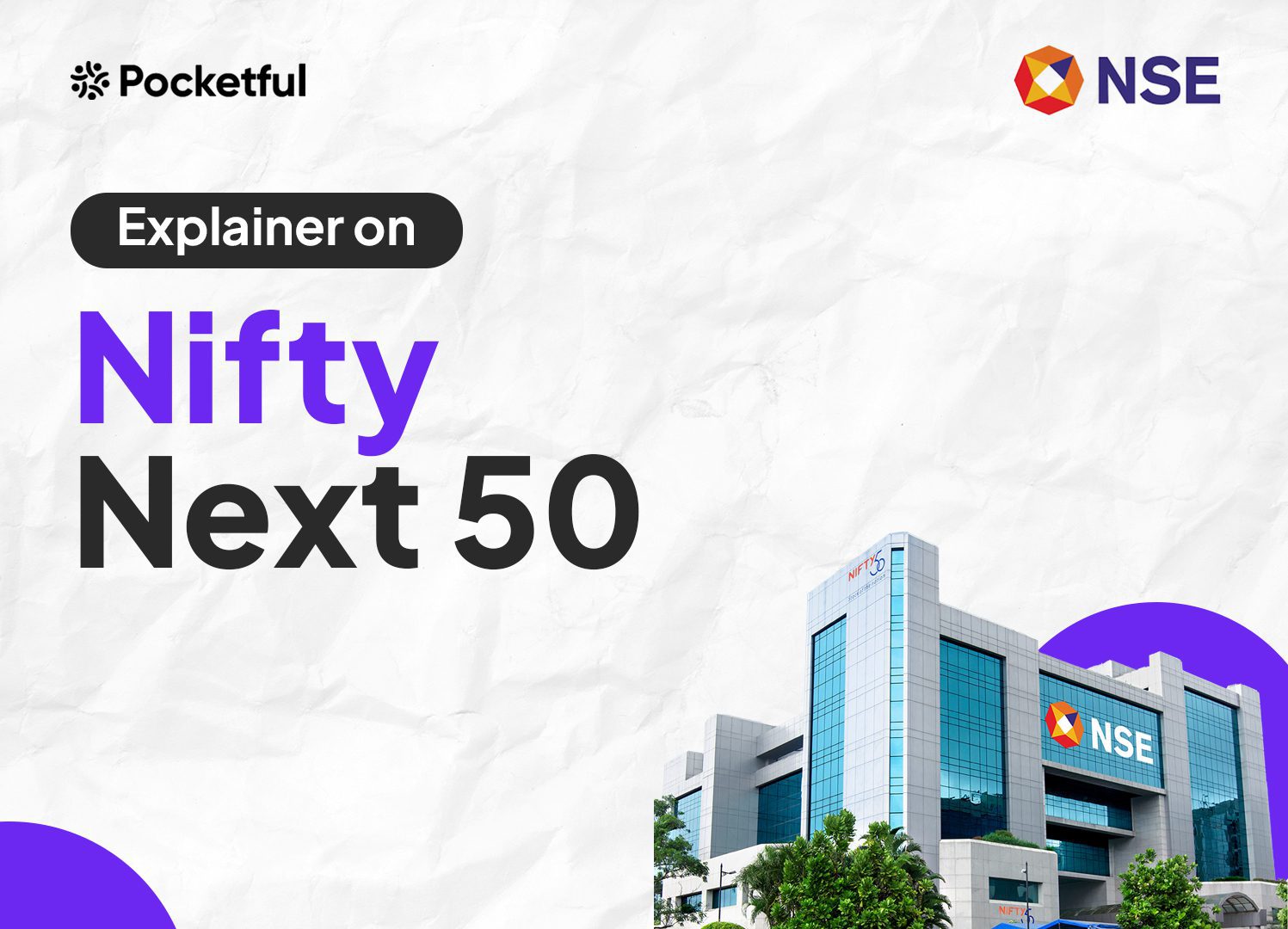| Type | Description | Contributor | Date |
|---|---|---|---|
| Post created | Pocketful Team | May-31-24 | |
| Add new links | Nisha | Mar-01-25 |

- Blog
- nifty next 50
NIFTY Next 50 – Meaning, Types & Features

Are the gains offered by the Nifty 50 overwhelming you? We are here to inform you that this is only the beginning; discover the possibilities of the Nifty Next 50 market movers!
This blog will explore the Nifty Next 50 and the recent development by NSE in detail.
What Is Nifty Next 50
The Nifty Next 50 index comprises 50 large-cap stocks from the Nifty 100 after the first 50 shares of the Nifty 100 are removed. Nifty Next 50 is a tool that investors use to keep track of and find prospective future large-cap companies. Nifty Next 50 companies can come from various industries, including finance, pharmaceuticals, FMCG, etc. As of September 2023, the Nifty Next 50 stocks comprise around 10% of the NSE’s entire free-float market capitalisation.

Correlation with Nifty 50
Sriram Krishnan, NSE’s Chief Business Development Officer, stated that the Nifty Next 50 index has a beta value of 0.95 and a 71% correlation with the Nifty 50 index.
Did you know?
Over 40 stocks have been upgraded to Nifty 50 within the past 18 years.
Sectoral Weightage
| Sectors | Companies | Weightage | Market Cap (in ‘000 Cr) |
| Finance | 7 | 13.52% | 10,45,871.20 |
| Power Generation & Distribution | 4 | 10.63% | 8,22,400.78 |
| Insurance | 3 | 10.48% | 8,10,640.24 |
| Aerospace & Defence | 2 | 7.07% | 5,46,957.10 |
| FMCG | 4 | 6.49% | 5,01,711.57 |
| Retail | 2 | 5.88% | 4,54,929.85 |
| Capital Goods – Electrical Equipment | 2 | 5.54% | 4,28,682.07 |
| Banks | 3 | 4.95% | 3,82,849.35 |
| Cement | 2 | 3.20% | 2,47,197.61 |
| E-Commerce/App based Aggregator | 2 | 3.08% | 2,38,422.56 |
| Gas Distribution | 2 | 3.06% | 2,36,450.42 |
| Refineries | 1 | 3.05% | 2,36,107.11 |
| Chemicals | 2 | 2.88% | 2,22,560.03 |
| Realty | 1 | 2.62% | 2,03,000.31 |
| Pharmaceuticals | 2 | 2.53% | 1,95,954.21 |
| Auto Ancillaries | 2 | 2.43% | 1,87,787.04 |
| Mining & Mineral products | 1 | 2.19% | 1,69,188.64 |
| Air Transport Service | 1 | 2.09% | 1,62,001.05 |
| Consumer Durables | 1 | 1.53% | 1,18,142.28 |
| Steel | 1 | 1.39% | 1,07,354.07 |
| Automobile | 1 | 1.38% | 1,06,992.52 |
| Railways | 1 | 1.12% | 86,616.00 |
| Alcoholic Beverages | 1 | 1.12% | 86,325.64 |
| Edible Oil | 1 | 1.02% | 78,687.86 |
| Paints/Varnish | 1 | 0.75% | 57,794.34 |
Based on the above table, we can conclude that the finance sector has the highest allocation of 13.52%, followed by the power sector, which has 10.63%.
Nifty 50 vs Nifty Next 50
As previously established, the Nifty 50 and Nifty Next 50 are components of the Nifty 100 index. However, there is a significant disparity in the size of the companies in these two indices, which causes large differences in the returns.
| Benchmark Name | 2021 | 2022 | 2023 | 2024 (YTD) |
|---|---|---|---|---|
| Nifty Next 50 TRI | 30.9 | 1 | 27.2 | 13.2 |
| NIFTY 50 TRI | 25.6 | 5.7 | 21.3 | 3.7 |
As the above table shows, the Nifty Next 50 Index has surpassed the Nifty 50 benchmark but reflects a higher volatility in returns.
Read Also: What is the NIFTY EV & New Age Automotive Index?
Introduction of Derivative Contracts by NSE
With approval from the Securities Exchange Board of India, the National Stock Exchange launched derivative contracts on the Nifty Next 50 index on April 24, 2024 (SEBI). In this derivative contract, the exchange will provide traders with three series of monthly index futures and option contract cycles—near-month, mid-month, and far-month. The contract typically ends on the final Friday of the expiration month.
Waiver of Transaction Cost
Furthermore, to encourage more people to participate actively in the Nifty Next 50 Index, the NSE has announced that it will waive transaction costs for trading in futures and options contracts on the index for the first six months ending October 31, 2024.
First Monthly Expiry Insight
The first monthly expiry is scheduled for 31 May 2024. The index has shown a turnover of more than 1100 crores within 3 weeks of its launch. The average daily turnover of the Nifty Next 50 Index is 50-60 crores, and the peak turnover is 82 crores. 7 ETFs and 13 mutual funds track the index.
Conclusion
The Nifty Next 50 index allows investors to profit from expanding industries and businesses. However, its volatility is comparable to mid-cap firms. Consequently, investors are urged to consider their risk tolerance before investing.
Frequently Asked Questions (FAQs)
In which year was the Nifty Next 50 Index introduced?
The Nifty Next 50 Index was introduced on 1st January 1997.
Which sector has the highest allocation in the Nifty Next 50 Index?
The banking & finance sector has the highest allocation of 13.26% in the Nifty Next 50 Index, followed by the power sector, which has a weightage of 10.64%.
Should I invest in Nifty Next 50 Index funds now?
Investment in the Nifty Next 50 Index offers a higher return than the Nifty 50 Index but also comes with higher volatility. Therefore, you can consider investing in this index if you have a longer investment horizon and can take risks.
Can I use the Nifty Next 50 Index derivative for trading purposes?
You can use the Nifty Next 50 derivative for trading purposes.
Is the stock in Nifty Next 50 a part of large-cap stocks?
Indeed, the stocks that comprise the Nifty Next 50 belong to the large-cap stock category. This is because the top 100 firms, determined by their free-float market capitalization, are classified as large-cap stocks.
Disclaimer
The securities, funds, and strategies discussed in this blog are provided for informational purposes only. They do not represent endorsements or recommendations. Investors should conduct their own research and seek professional advice before making any investment decisions.